By Joseph R. Svinth
Copyright © 2001 Joseph R. Svinth. All rights reserved.
From "Sports and Physical Training in Modern Japan" by Tsuneo Matsudaira, Transactions and Proceedings of the Japan Society, London, 8 (1907/1909), 120.
When Tsuneo Matsudaira read his paper to the Japan Society of London on April 8, 1908, his words were accepted as true. However, it is still worth investigating his "very few" exceptions.
BRITAIN
That I, the only lady exponent of Ju-jitsu, should point out its disadvantages may seem strange. Having taken it up as a profession it would seem to be more politic on my part to swell the chorus of its praises rather than publish its faults. But why not speak openly of its weak points instead of trying to hide them? There is quite enough convincing proof of the grand results of even a moderate training in Ju-jitsu to allow of absolute honesty when arguing the question of its pros and cons.
From "Ju-Jitsu: The New Exercise" by Mrs. Roger [Emily] Watts, The World's Work and Play Magazine, August 1905
Emily Diana Watts started learning jujutsu around 1903. Her instructor was Sadakazu "Raku" Uyenishi, a first-rate judoka who wrestled in London music halls, operated a judo club at Golden Square in Soho and published an excellent Text Book of Ju-Jutsu as Practised in Japan (London: Athletic Publications, 1905).
Within three years Watts had her own class of fifteen boys at Prince's Skating Rink, in Knightbridge, and her own book, The Fine Art of Jujutsu (London: William Heinemann, 1906). While the photographs illustrating the book suggest that her judo was nothing special, the book itself is interesting for two reasons. First, what Watts was showing was not partner-assisted stretching, but honest-to-goodness judo. Second, the introduction by Her Grace the Duchess of Bedford and the preface by Sir Lauder Brunton, MD, D.Sc., LLD Edinburgh, LLD Aberdeen, FRS, indicate the social class toward which the expensively bound and lavishly illustrated hardback was directed.
Watts was not the only British woman doing judo, only the richest. In 1907, Marie Studholme was shown in photos with Yukio Tani, and instructors at the Oxford Street judo school run by Tani and Taro Miyake from 1905 to 1907 included Phoebe Roberts. From Blaina, Monmouthshire, Roberts began training at Sadakazu Uyenishi's dojo around 1903. Three years later, aged 16, she turned professional and then contested with Lucy Weston in the British women's jujitsu championships of 1906 and 1907. After that, she went on tour with Miyake and Tani.
When Uyenishi left Britain in 1908, his student William Garrud took over teaching the men while Garrud's wife Edith took over teaching the women and children. Photographs of "Mrs. Garrud, a well-known Suffragette," throwing a uniformed British policeman appeared in the London Sketch on July 6, 1910. Soon after, Punch printed a cartoon showing uniformed policemen cowering before a solitary "Ju-Jutsu Suffragette."
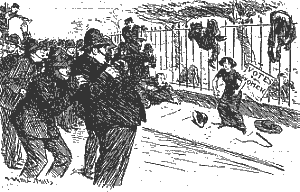
What we may expect when our women all become Ju-Jutsu Suffragettes. By R.Wallis Mills, originally in Punch, and reprinted in Health & Strength, July 23, 1910.
In January 1918 Gunji Koizumi founded an amateur judo club called the Budokwai in London. The first 36 members were Japanese. Then British men who had lived in Japan began joining and finally, in April 1919, Katherine White-Cooper (member number 60) became the Budokwai's first female member. Recalled White-Cooper in the Budokwai Quarterly Bulletin in April 1948:
Four of these women achieved shodan (black belt) ranking before the end of World War II. These were Eva Anderson and Beatrice Woolhouse in 1932, A.H. Barker in 1935, and Dame Enid Russell-Smith in 1945. However, as their promotions were based more on skill in kata (forms) rather than skill in randori (free wrestling), the women's ranks bore little connection to men's ranks. Women's promotions were also a long time coming; Anderson, for example, began in 1920 while Woolhouse began in 1924.

Left to right: Unidentified, Kitabatake (Berlin), Ishiguro (Paris), Yukio Tani (Budokwai), Gunji Koizumi (Budokwai), Beatrice Woolhouse (Budokwai). The occasion was a contest between a German team and a British team held in London in 1938. Photo courtesy the Budokwai.
During annual public displays the Budokwai women got the opportunity to show their skill at kata. During these demonstrations, their partners were either one another or Koizumi. In a letter to Robert W. Smith dated November 24, 1954, the always outspoken British judoka E.J. Harrison dryly noted that such displays rarely failed "to bore the spectators and to evoke only perfunctory applause."
During the mid-1930s, British women also trained in judo at the Anglo-Japanese Judo Club in Strathmore Gardens. Yukio Tani's daughter taught the Saturday afternoon women's class. Also, beginning in 1938, the British government began encouraging women to attend weekly "keep fit" classes. Self-defense was often part of the training, and for women this often included judo because it was advertised as being less dependent on physical strength relative to the opponent than were boxing or wrestling.
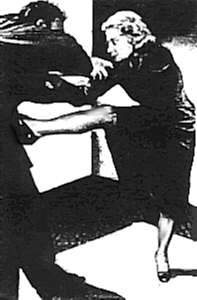
"An overly romantic young man lays heavy hands upon a young English girl who knows how to take care of herself in such emergencies. She pushes him away from her and quickly plants a foot in his midriff." From Seattle Post-Intelligencer, May 8, 1938.
Finally, the first British woman to get dan grade in Japan was Sarah Mayer, who received her grade from the Kyoto Butokukai in February 1935. The Budokwai historian Richard Bowen notes, however, that there is some question whether she actually accepted the grade, as in letters to Gunji Koizumi she indicated that she was not sure she deserved the rank. At any rate, Mayer returned to Britain in mid-1935, bringing future Japanese Olympic freestyle wrestling coach Ichiro Hatta with her. She practiced at the Budokwai for a while before World War II, and then set up a small dojo in her home in Burgh Heath.
EUROPE
From "Leather and Lingerie" by Marion Lewis, The Ring, December 1933, 40-41.
Until the 1950s, Europeans typically associated women's boxing and wrestling with vaudeville acts rather than proper young ladies. However, in 1906 Irving Hancock's Physical Training for Women by Japanese Methods was translated into French, and throughout the 1910s French strongmen taught self-defense courses called "jiu-jitsu".
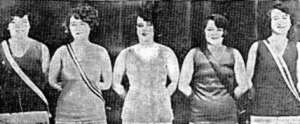
"German Girl Boxers Now in United States. The above quintet of athletic frauleins from the land of the pretzel and schnapps are appearing in a flashy boxing act on a tour of American vaudeville houses. The girls are cleer performers with the mitts and put on some snappy bouts. Miss Steffie Bernert of Berlin, shown in the center of the group, is the champion of the act." From The Boxing Blade, 5:19, April 12, 1924.
In 1924 Hikoichi Aida and Keishichi Ishiguro introduced Kodokan judo to Paris, and during the late 1920s the painter Tsugiji Fujita provided some private judo instruction to his friends. However, there were no known female judoka in France until 1935. The pioneering instructor was Mikonosuke Kawaishi, and his female students included the sister of Moshe Feldenkrais. And, while Kawaishi did not teach judo in France from 1943 to 1948, by 1950 Henry Plée's Annuaire du judo international reported 7,542 judoka in France, 130 of whom were female.
In Germany, Erich Rahn began teaching jujutsu to Berlin police in 1906; the style taught was probably Tsutsumi Hozan Ryu. Jujutsu grew in popularity following the First World War, and by 1930, there were three jujutsu federations and over 100 clubs in Germany and Austria. But, after a Budokwai team thrashed the Germans during a 1929 contest, most of Germany's 5,600 male and 137 female judoka started claiming to study Kodokan judo rather than Rahn's "European jiu-jitsu". Then in 1934 the Nazis decreed that the duty of Aryan women was to be mothers and wives rather than athletes, and as a result no German woman was promoted to black belt grade until 1953.
In Italy, an All-Italy Judo League was formed in Rome in 1924. But both the Pope and Il Duce were against "unwomanly athletics" and as a result the All-Italy Judo League had no known female members. The pre-World War II Czech, Hungarian, Latvian, Rumanian, Scandinavian, and Swiss judo clubs also had no known female members. If anyone knows differently, please send me details at jrsvinth@juno.com.
UNITED STATES
It is particularly the art of self-defence which these women are learning, and they have progressed so far that they can without difficulty or strain lift and throw a body weighing 200 pounds. An assailant rushing toward them they would throw by a light touch on the knee, wrist or cheek, using the force of his own impetus against him.
From "A Japanese Woman Teaching American Girls Japan's Secret Science of Self Defence," New York World, Sunday Magazine, May 29, 1904, 1.
The women in the class described by the New York World article of May 1904 were wealthy socialites -- Martha Blow Wadsworth, Maria Louise ("Hallie") Davis Elkins, Grace Davis Lee, Katherine Elkins, Jessie Ames, and Re Lewis Smith Wilmer. Their inspiration to study judo included Martha Blow Wadsworth wanting to show the world that she could do anything Theodore Roosevelt could do. (From New York herself, Wadsworth despised Roosevelt.)
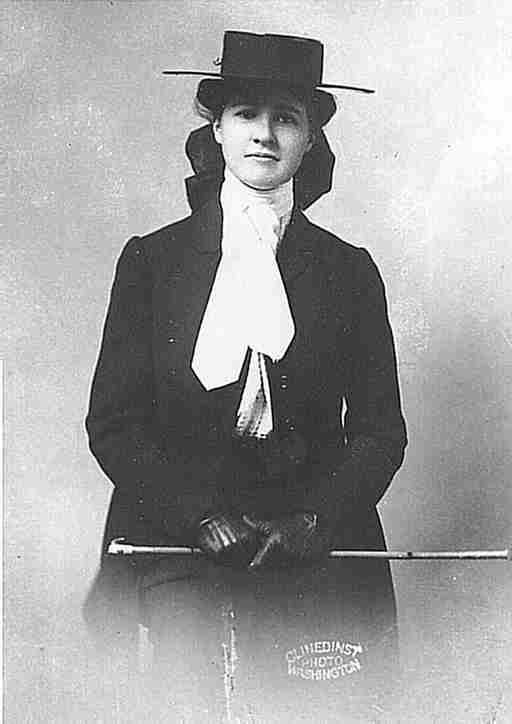
Katherine Elkins, circa 1905. Photo courtesy of Lee Norton.
However, they were also inspired by H. Irving Hancock's recent book, Physical Training for Women by Japanese Methods. Wrote reviewer Priscilla Leonard in Current Literature in August 1904:
This is calculated to make the Gibson girl, with all her athletic grace, sit up straight and read on eagerly.
Obviously most American women were not wealthy socialites, and in the workplace, they were subjected to considerable sexual harassment. Therefore defenses against what were then called mashers were desired.

"For purely domestic controversies, a few well-directed claws at the head of the house may prove sufficient to make him pass over the change, but out in the open the way to dispose of a masher with neatness and dispatch is to give him grip No. 7 followed by hold No. 9." A Herb Roth drawing, New York World, January 30, 1916.
Between 1905 and 1915, boxing was viewed as an excellent answer to mashers. As Violet Lorraine wrote in the Seattle Times in November 1910:
Accordingly, I resolved that if he ever bothered me I would proceed on rational lines – his extermination, root and branch. The time came when he did bother me and that was my hit to prepare for his proper extermination in the only way that would do the work, namely, by the application of physical force.

"Miss Teddy Myers, of Rome, Georgia, at the age of twenty-four claims the heavyweight woman's wrestling championship of the world… Miss Myers claims that wrestling is the best possible form of exercise for women. 'It makes use of more muscles than any other exercise,' she says. 'One needs suppleness as well as strength, and that's where wrestling comes in. Wrestling, in my opinion, trains the mind more than any other developing sport. It teaches you to be resourceful, to think quickly and to act instantly. If a woman considers beauty alone, wrestling is invaluable, for it develops her figure evenly, leaving no unsightly bunches of muscles showing in one place at the expense of others.'" From "Woman Wrestler Who Claims the Heavyweight Crown," Seattle Post-Intelligencer, January 29, 1928.
For example, Danzan Ryu jujutsu founder Seishiro "Henry" Okazaki taught a women's self defense class at Hilo High School in 1924, and in 1929 he self-published a book called The Science of Self-defense for Girls & Women. Hilo promoters of women's judo included the YWCA's Miss Harrison while Maui promoters included Floy Robinson, Kennette Griffith, Myrtle Nelson, Emma Cawdry, and Elva Class. Early Hawaiian female black belts included Shizuko Murasaki, Matsue Honda, and Yasue Kuniwake.
By the 1930s, the Young Women's Hebrew Association (YWHA) was also teaching jujutsu-based self-defense classes. For example, the Japan Times noted on April 6, 1931, that "Minnie Levenson of the YWHA Washington Heights [in New York] shows to what degree woman's strength rises when fortified with the Japanese science of wrestling, Jiu Jitsu. Minnie is holding Joseph Greenhut helpless in her grasp. The girls of the 'Y' are being trained in the science the better to combat mashers they might encounter."
A few American women also trained in Kodokan judo before World War II. For example, when judo founder Jigoro Kano attended a judo exhibition given by the New York Jiu-Jitsu Club on July 16, 1936, Seattle's Japanese-American Courier reported that "among the judoists were not a few Japanese and American women who have taken up the art." The instructor at the New York club was T. Shozo Kuwashima, a man remembered today mostly for his 1938 book called Judo: Forty-One Lessons in the Modern Science of Jiu-Jitsu.
The first American woman to gain dan grade from the Kodokan in Japan was Hawaii's Shizumo Ozumi on November 18, 1936. Meanwhile, in California, Katsko [sic] Yamaguchi, a 16-year-old Upland girl, was graded ni-kyu [second brown] in June 1939, and said to be desirous of going to Japan to train.
JAPAN
'You like see what Japanese woman can do?'
I assured him that it would give me great pleasure to have such an exhibition…
She was laughing as she approached, … a supple young woman bounding with the vim of life, and graceful in every line of contour.
While I stood looking at her, the little woman halted before me, made a polite bow, and then backed away, in the manner that is common to students of jiu-jitsu when inviting combat. She was fully six inches shorter than I and at a great disadvantage in point of weight…
I bowed, and we backed off a little way, then approached each other sinuously, each looking for an opening. There was a clinch that lasted, as nearly as I could judge, about five seconds. Three seconds later I was compelled to pat the floor in token of surrender. There were five bouts in all, of which I secured the distinction of winning one…
From Physical Training for Women by Japanese Methods by H. Irving Hancock (New York: G.P. Putnam's Sons, 1904), 4-7.
As Hancock noted in Physical Training for Women by Japanese Methods, some Japanese women practiced jujutsu before 1900. In general, these were relatives of teachers, and as in Britain some went into professional wrestling, both at home and abroad.

"Women who study judo specially practice taking away knives." From Arthur E. Grix, Japans Sport in Bild und Wort (Berlin: Wilhelm Limpert-Verlag, 1937).
However, during the 1910s Japanese educators became interested in introducing judo into high school girls' gym programs. For example, on July 3, 1913 Japan Times reported:
The Seijyo Girls' High School, Ichigaya, Ushigome, is the school that has entered on this new enterprising departure in the education of the fair sex. Mr. Miyata, Principal of the school, has opened this new course for girls, not necessarily to turn out ring-fighters, but on the principle of healthy body-healthy mind.
A class-room has been turned into a training camp. The inauguration of the new course was solemnized a few days ago at the school. Some dozen girls have been selected from the applicants, to start in the course with an able master of jujutsu art. They are daily in hard grueling training.
Principal Miyata hopes that his experimental attempt will meet with successful results, and will be popular with women as well as men.
In those days, few Japanese schools were coed, and so in 1926 the Kodokan established a women's section for the purpose of training future judo teachers. One of the first teachers was Miss Misao Yamagata, who had been a private student of Jigoro Kano.

Jigoro Kano in the women's section of the Kodokan, circa 1935. Photo courtesy Shinji Kozu.
An enrollment book for women was begun in 1931. The first woman to earn dan grade was Katsuko Osaki in January 1933. Other early female grade holders included Masako Noritomi, Ayako Akutagawa, Yasuko Morioka, Masako Wada, and Keiko Fukuda.
The Kodokan's women's program was not large: in January 1935, it had just fifteen members. The young women (most were in their late teens or early twenties) trained primarily in kata, and the idea was that they would become physical education or judo teachers.
Ayako Akutagawa, 2-dan, circa 1936. Photo courtesy Shinji Kozu.
A handful of Japanese women also continued practicing traditional martial arts and ways. For example, on September 15, 1938, a Hitler Youth group visiting Japan saw a budo demonstration whose participants included Mrs. Takeyo Suzuki, Mrs. Kaneko Imai, and Mrs. Kimiko Sugino. Styles demonstrated included Shinnoshindo-ryu jujutsu, which was the same style studied by William E. Fairbairn of the Shanghai Municipal Police.
WORLD WAR II
From "Self-Defense by Women" by Major William E. Fairbairn, New York Times Magazine, September 27, 1942, 22-23
During World War II, the ideas of self-defense, physical fitness, and empowerment were combined and, in the United States the Women's Army Auxiliary Corps alone, exposed at least 20,000 women to judo during training. So, as Ruth Gardner wrote in Robert W. Smith's A Complete Guide to Judo (Rutland, VT: Charles E. Tuttle, 1958):
[So she started in judo. Then, following service in Europe with the US Army Air Force] I returned at war's end to Chicago where John Osako (go-dan) began to coach and groom me for that acid test, the shodan degree for women. We studied Newaza-no-Kata and Shime-no-Kata. He sharpened my throwing techniques…
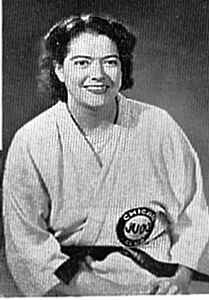
One night, in anticipation of one of the city-wide contests, John called for a practice shiai. There were only nine men on the mat that night – I made the tenth. In order to have it come out even, John decided to put me on one of the teams. As my readers no doubt know, this is strictly against the rules, since women are not supposed to compete in contest – especially against men. However, I was more than willing… [Her opponent was 5'2" Dick Doi.] Several times I almost straight armed him to keep him from getting close. Repeated success in this maneuver led me to become a little careless and the next thing I knew Doi's anxious face hovered over me and I heard him say, 'Are you all right, Ruth?' That was the end of women taking part in shiai, practice or otherwise.

Gunji Koizumi demonstrating with Iris Dehnel, watched by Ann Snow, Yvonne Myers, and Doreen Tilley, circa 1955. Photo courtesy the Budokwai.
And so it was.
FOR FURTHER READING
General background